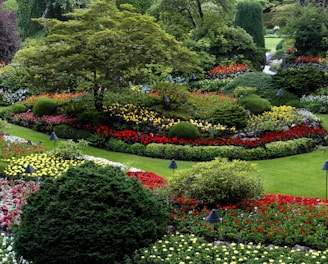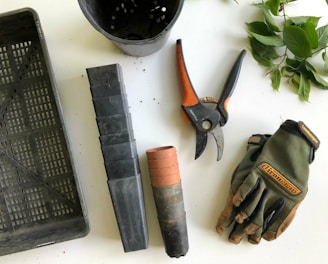
Low-Maintenance Landscaping Ideas for Busy Homeowners
By Amanda Eleter
In today's fast-paced world, many homeowners find it challenging to dedicate the time and effort to maintaining a traditional, high-maintenance garden. Low-maintenance landscaping offers an appealing solution, allowing busy individuals to enjoy beautiful and functional outdoor spaces without the constant upkeep. By prioritizing ease of care, homeowners can spend less time on yard work and more time relaxing and enjoying their gardens.


Benefits of Easy-Care Landscapes for Busy Homeowners
Easy-care landscapes provide several significant benefits:
Time-Saving: With less time spent on watering, weeding, mowing, and other chores, homeowners can focus on other activities they love.
Cost-Effective: Low-maintenance gardens often require fewer resources, such as water, fertilizers, and pesticides, leading to lower overall costs.
Sustainability: These landscapes typically incorporate eco-friendly practices, such as using native plants and efficient irrigation systems, contributing to environmental conservation.
Aesthetic Appeal: Low maintenance does not mean sacrificing beauty. Well-designed, easy-care gardens can be visually stunning and enhance the property's overall curb appeal.


Purpose of the Article: Providing Practical and Stylish Landscaping Ideas
The purpose of this article is to offer practical and stylish landscaping ideas that cater to the needs of busy homeowners. Whether you are looking to revamp your entire garden or make small changes, this guide will provide you with inspiration and actionable tips to create a low-maintenance landscape that suits your lifestyle.
Understanding Low-Maintenance Landscaping
Definition and Key Principles
Low-maintenance landscaping refers to designing and managing outdoor spaces in a way that minimizes the time, effort, and resources required for upkeep. Key principles include:


Right Plant, Right Place: Selecting plants that thrive in your local climate and soil conditions reduces the need for constant care.
Efficient Irrigation: Implementing water-wise practices and systems ensures plants receive the necessary hydration without wastage.
Mulching: Using mulch to suppress weeds, retain moisture, and improve soil health.
Smart Design: Creating a landscape layout that is easy to navigate and maintain, incorporating hardscape elements to reduce planting areas.
Common Misconceptions About Low-Maintenance Landscaping
Several misconceptions about low-maintenance landscaping can deter homeowners from embracing this approach:
Boring and Unattractive: Some believe that low-maintenance gardens lack visual appeal. In reality, these landscapes can be vibrant, diverse, and aesthetically pleasing.
Limited Plant Choices: While it may seem that low-maintenance options are restrictive, there is a wide variety of plants and design elements that fit this category.
High Initial Costs: Although there can be upfront expenses for installation and design, the long-term savings on maintenance and resources make it cost-effective.


Choosing the Right Plants
Native Plants and Perennials
Benefits of Using Native Plants
Native plants are adapted to the local climate and soil, making them naturally low-maintenance choices. Benefits include:
Resilience: Native plants are more resistant to local pests and diseases.
Water Efficiency: These plants typically require less water once established.
Support for Local Ecosystems: They provide habitat and food for local wildlife, promoting biodiversity.
Low-Maintenance Perennials That Thrive in Various Climates
Perennials are plants that return year after year with minimal effort. Some low-maintenance perennials include:
Lavender: Drought-tolerant and fragrant, ideal for various climates.
Black-eyed Susan: Hardy and vibrant, with long-lasting blooms.
Hosta: Perfect for shaded areas, with attractive foliage and low water needs.
Drought-Tolerant Plants
Advantages of Drought-Tolerant Species
Drought-tolerant plants are designed to survive with minimal water, making them perfect for low-maintenance landscapes. Advantages include:
Reduced Water Usage: These plants thrive with less frequent watering, conserving water.
Lower Maintenance: With fewer watering needs, there is less daily upkeep.
Adaptability: Many drought-tolerant species are hardy and can thrive in challenging conditions.
Popular Drought-Tolerant Plants for Different Regions
Succulents (e.g., Aloe Vera, Agave): Ideal for arid regions, they store water in their leaves.
Sage: A versatile plant that does well in various climates and provides aromatic foliage.
Russian Sage: Known for its drought resistance and attractive, silvery leaves.
Simplifying Lawn Care
Reducing Lawn Size
Benefits of Smaller Lawns
Reducing the size of your lawn can significantly cut down on maintenance. Benefits include:
Less Mowing: Smaller lawns mean less time spent mowing.
Water Savings: Reduced lawn area decreases water consumption.
Increased Space for Other Features: Allows for more planting beds, patios, and other low-maintenance elements.
Alternatives to Traditional Grass Lawns
Consider these alternatives to traditional grass:
Ground Covers: Plants like clover or creeping thyme that provide green coverage with less upkeep.
Artificial Turf: A low-maintenance option that looks like real grass without the need for mowing or watering.
Gravel or Mulch Areas: Create attractive, maintenance-free zones with gravel or mulch.


Low-Maintenance Grass Varieties
Types of Grass That Require Less Watering and Mowing
Opting for low-maintenance grass varieties can make lawn care easier. Some options include:
Fescue: Known for its drought tolerance and low mowing needs.
Buffalo Grass: A native grass that thrives with minimal water and maintenance.
Zoysia: Slow-growing and drought-resistant, requiring less frequent mowing.
Tips for Maintaining These Grass Varieties
Proper Watering: Water deeply but infrequently to encourage deep root growth.
Mowing Techniques: Keep the mower blades sharp and mow at the recommended height for each grass type.
Fertilization: Use a slow-release fertilizer to provide consistent nutrients without frequent applications.
Incorporating Hardscape Elements
Benefits of Hardscaping for Reducing Maintenance
Hardscaping involves the use of non-living materials in your landscape design, which can significantly reduce maintenance efforts. By incorporating hardscape elements, you can:
Minimize Planting Areas: Less time spent on watering, weeding, and pruning.
Increase Durability: Hardscape features are often more durable and long-lasting than plant-based elements.
Enhance Functionality: Provides practical areas for outdoor activities and reduces lawn space.
Popular Hardscape Features
Patios: Create outdoor living spaces that are perfect for entertaining and relaxing.
Pathways: Define walking areas with materials like stone, gravel, or pavers, reducing wear on the lawn.
Rock Gardens: Add visual interest and require minimal upkeep compared to traditional gardens.
Sustainable Materials
Eco-Friendly Hardscaping Materials
Choosing sustainable materials for hardscaping can further enhance the eco-friendliness of your landscape:
Recycled Materials: Utilize recycled concrete, bricks, or reclaimed wood to reduce environmental impact.
Natural Stone: Opt for locally-sourced stone to minimize transportation emissions.
Long-Lasting and Low-Maintenance Options
Long-lasting materials ensure your hardscape features remain in good condition with minimal upkeep:
Composite Decking: Resistant to rot, insects, and weathering, requiring less maintenance than natural wood.
Permeable Pavers: Allow water to seep through, reducing runoff and maintenance needs.


Efficient Irrigation Systems
Drip Irrigation
How Drip Irrigation Works
Drip irrigation systems deliver water directly to the root zone of plants through a network of tubes and emitters. This method ensures precise watering, minimizing evaporation and runoff.
Benefits of Drip Systems for Conserving Water and Reducing Maintenance
Water Efficiency: Reduces water usage by targeting the root zone and preventing waste.
Healthier Plants: Consistent moisture levels promote healthy plant growth.
Less Weeding: Minimizes weed growth by keeping water away from weed-prone areas.
Smart Irrigation Controllers
Features of Smart Irrigation Systems
Smart irrigation controllers use weather data and soil moisture sensors to adjust watering schedules automatically. Key features include:
Remote Access: Control your irrigation system from your smartphone or computer.
Customizable Programs: Set specific watering schedules based on plant needs and weather conditions.
How Technology Can Simplify Landscape Maintenance
Smart irrigation systems reduce the need for manual adjustments, ensuring your landscape receives optimal watering with minimal effort. This technology can save time, water, and prevent over- or under-watering.


Easy-Care Garden Design
Mulching and Ground Covers
Benefits of Using Mulch and Ground Covers
Mulching and ground covers offer several advantages for low-maintenance gardens:
Weed Suppression: Prevents weed growth by blocking sunlight.
Moisture Retention: Helps soil retain moisture, reducing the need for frequent watering.
Soil Improvement: Organic mulch breaks down over time, enriching the soil.
Types of Mulch and Ground Covers That Reduce Weeding and Watering
Organic Mulch: Bark, wood chips, and compost are excellent choices for enriching the soil.
Inorganic Mulch: Gravel, pebbles, and rubber mulch are durable options that do not decompose.
Ground Covers: Low-growing plants like creeping thyme, sedum, and vinca provide attractive, low-maintenance coverage.


Container Gardening
Advantages of Container Gardens for Busy Homeowners
Container gardens are perfect for those with limited time or space:
Flexibility: Easily move and rearrange plants as needed.
Control: Manage soil quality and moisture more effectively.
Minimal Weeding: Containers reduce the likelihood of weeds.
Low-Maintenance Container Plants and Arrangements
Succulents: Require minimal watering and thrive in various conditions.
Herbs: Easy to grow and maintain, providing fresh ingredients for cooking.
Annuals: Brighten up your space with seasonal color, requiring minimal long-term commitment.
Seasonal Maintenance Tips
Spring and Summer
Essential Tasks for Warm-Weather Landscaping
Mulching: Apply fresh mulch to retain moisture and suppress weeds.
Pruning: Trim shrubs and trees to promote healthy growth and shape.
Watering: Ensure efficient irrigation to keep plants hydrated during hot months.
Tips for Keeping Your Landscape Vibrant with Minimal Effort
Group Plants by Water Needs: Place plants with similar water requirements together to simplify irrigation.
Use Slow-Release Fertilizer: Provides nutrients gradually, reducing the need for frequent applications.
Install Shade Structures: Protect sensitive plants from intense sunlight and reduce watering needs.
Fall and Winter
Preparing Your Landscape for Colder Months
Clean Up Debris: Remove fallen leaves and dead plants to prevent disease and pests.
Mulch and Insulate: Add a layer of mulch to protect plant roots from freezing temperatures.
Drain Irrigation Systems: Prevent damage by draining and winterizing your irrigation system.
Low-Maintenance Tasks to Ensure Year-Round Beauty
Plant Perennials: Choose hardy perennials that require minimal care through the seasons.
Prune Dormant Plants: Trim back perennials and shrubs during their dormant period to encourage healthy growth in spring.
Plan for Spring: Use the winter months to plan and prepare for upcoming gardening projects.
Incorporating Personal Touches
Customizing Your Space
Adding Personal Elements to Your Landscape
Decorative Features: Incorporate garden art, sculptures, and personalized decor to reflect your style.
Functional Spaces: Design areas for specific activities like dining, relaxing, or playing.
Balancing Functionality with Aesthetics
Practical Paths: Ensure pathways are both functional and attractive.
Layered Planting: Combine plants of different heights and textures for visual interest.
Creating Relaxing Retreats
Ideas for Designing Serene, Low-Maintenance Outdoor Spaces
Seating Areas: Include comfortable seating for relaxation and enjoyment.
Water Features: Add a small fountain or pond for a calming ambiance.
Privacy Screens: Use hedges, fences, or trellises to create private, intimate spaces.
Incorporating Features That Promote Relaxation and Enjoyment
Outdoor Lighting: Soft, ambient lighting enhances the atmosphere and usability of the space.
Low-Maintenance Plants: Choose plants that require minimal care and provide year-round interest.
By incorporating these low-maintenance landscaping ideas, busy homeowners can create beautiful, functional, and sustainable outdoor spaces that enhance their quality of life without demanding constant upkeep.








